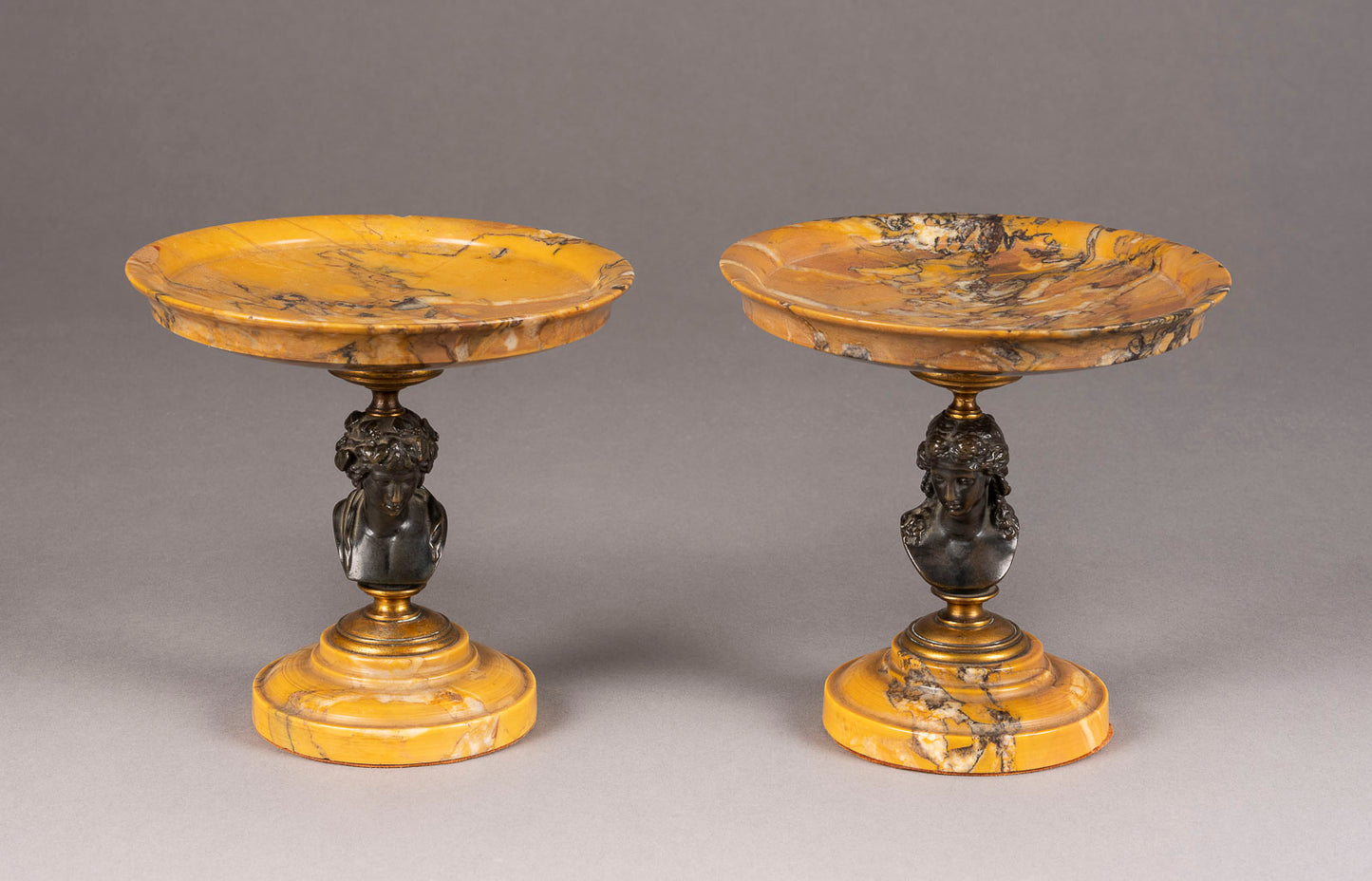Artemisia Fine Arts & Antiques Ltd
Classical Bronze Tazzas Pair Brocatello di Siena Marble c.1850-1900 Grand Tour
Classical Bronze Tazzas Pair Brocatello di Siena Marble c.1850-1900 Grand Tour
Couldn't load pickup availability
A Dainty Pair of Classical Tazzas in Bronze and Brocatello di Siena c.1850-1900
An exquisite and museum-quality pair of classical tazzas (shallow decorative bowls on pedestals) featuring bronze busts in antique style mounted on rising profiled round feet of precious Brocatello di Siena marble. Dating to circa 1850-1900, these elegant pieces exemplify the Grand Tour aesthetic and the 19th-century passion for classical antiquity. Each tazza stands 13 cm tall with 13.5 cm diameter, creating perfect proportions for display as decorative objects or functional vessels. In good condition and offered as a matched pair, these tazzas represent the finest traditions of 19th-century European decorative arts.
The Grand Tour Tradition
These tazzas embody the Grand Tour tradition - the 18th and 19th-century custom of wealthy Europeans, particularly British aristocrats, traveling through Europe to experience classical art, architecture, and culture. Travelers collected or commissioned objects inspired by classical antiquity as souvenirs and educational mementos. Bronze reproductions of classical sculptures, often mounted on precious marble bases, became highly sought-after Grand Tour objects. These pieces allowed collectors to bring the spirit of ancient Greece and Rome into their homes, demonstrating cultural sophistication and classical education. Grand Tour objects remain highly collectible today for their historical significance, craftsmanship, and aesthetic appeal.
Classical Bronze Busts - Antique Style
Each tazza features a bronze bust executed in antique style - either female or male figures rendered with the idealized beauty, refined features, and classical proportions characteristic of Greco-Roman sculpture. These busts demonstrate the sculptor's understanding of classical aesthetics and technical skill in bronze casting. The antique style references the great sculptural traditions of ancient Greece and Rome, when bronze portrait busts represented the pinnacle of artistic achievement. The busts' positioning as shafts supporting the tazza bowls creates elegant vertical emphasis while showcasing the sculptural quality of the bronze work.
Bronze Casting - Technical Excellence
The bronze busts demonstrate accomplished casting technique, likely using the lost-wax (cire perdue) method where a wax model is created, encased in refractory material, the wax melted out, and molten bronze poured into the resulting cavity. This demanding process requires perfect control of temperatures, alloy composition, and finishing techniques. The bronze's patination - the surface coloration developed through chemical processes and age - adds depth and character while protecting the metal. The quality of casting, finishing, and patination indicates these pieces were created by skilled craftsmen working to high standards.
Brocatello di Siena Marble - Precious Stone
The round feet are crafted from Brocatello di Siena, one of the most beautiful and historically significant Italian marbles. Quarried near Siena in Tuscany, this marble is characterized by its warm golden-yellow background with dramatic red-brown and purple veining, creating rich, complex patterns. Brocatello di Siena was prized in ancient Rome and experienced renewed popularity during the Renaissance and 19th century. The marble's rarity, beauty, and historical associations made it perfect for Grand Tour objects and luxury decorative arts. The use of this precious marble elevates these tazzas from mere decorative objects to examples of fine craftsmanship using premium materials.
Rising Profiled Round Feet - Elegant Form
The marble feet feature rising profiled design - carefully shaped moldings that create visual interest and elegant proportions. The profiling demonstrates understanding of classical architectural principles, where moldings create transitions between elements and add refinement to overall form. The round shape provides stable base while the rising profile creates graceful transition from base to bronze shaft. This attention to proportional relationships and decorative detail distinguishes quality 19th-century decorative arts from mass-produced items.
Tazza Form - Classical Vessel Type
The tazza (Italian for cup or bowl) is a shallow bowl on raised foot or pedestal, a form with ancient origins that became popular in Renaissance and later European decorative arts. Tazzas served both functional purposes (holding fruit, sweets, or decorative objects) and purely aesthetic roles as sculptural centerpieces. The form's classical associations and elegant proportions made it perfect for Grand Tour-inspired objects. Pairs of tazzas were particularly desirable for creating symmetrical arrangements on mantels, sideboards, or tables.
Matched Pair - Enhanced Value
These tazzas are offered as a matched pair - significantly enhancing their value and desirability. Pairs allow for symmetrical display arrangements highly valued in classical and traditional interior design. Finding matched pairs that have remained together through 120-170 years is increasingly rare, as pairs are often separated through inheritance, sale, or loss. The survival of this pair intact dramatically increases both aesthetic appeal and market value compared to single examples.
Dimensions - Perfect Proportions
At 13 cm height and 13.5 cm diameter, these tazzas offer dainty, refined scale perfect for various display settings. The compact dimensions make them suitable for mantels, side tables, vitrines, or grouped arrangements without overwhelming spaces. The nearly equal height and diameter create harmonious proportions that please the eye. This size represents the sweet spot for decorative objects - substantial enough to command attention, compact enough for versatile placement.
Circa 1850-1900 Dating - Victorian to Belle Époque
The circa 1850-1900 dating spans the Victorian period through the Belle Époque, an era of tremendous interest in classical antiquity, Grand Tour collecting, and refined decorative arts. This period saw sophisticated craftsmanship, access to finest materials, and strong market for classically-inspired objects among educated, affluent collectors. Objects from this era represent the last generation of traditional craftsmanship before industrialization transformed decorative arts production.
Condition - Good
Described as in good condition, these tazzas have survived 120-170 years with their integrity intact. Good condition in antique decorative arts indicates honest wear consistent with age and use, no significant damage or inappropriate restoration, and overall soundness that allows continued enjoyment and display. The bronze patination and marble's natural aging add character and authenticity. This condition level is ideal for collectors who appreciate authentic antiques with honest patina rather than over-restored pieces.
Materials Combination - Aesthetic Harmony
The combination of bronze and Brocatello di Siena marble creates rich aesthetic harmony - the bronze's dark patina contrasts beautifully with the marble's warm golden tones and dramatic veining. This color and texture contrast demonstrates sophisticated understanding of how materials interact visually. The combination also represents the marriage of sculptural art (bronze busts) with architectural/decorative art (marble bases), creating objects that transcend simple categorization.
Investment Value and Collectibility
Matched pairs of Grand Tour objects in bronze and precious marble represent solid investment opportunities. The combination of classical subject matter, quality materials, accomplished craftsmanship, matched pair status, and good condition creates strong appeal among collectors of Grand Tour objects, 19th-century decorative arts, classical antiquities, and bronze sculpture. As authentic period pieces become scarcer and appreciation for traditional craftsmanship grows, quality examples show consistent market strength.
Versatility and Display
These tazzas work beautifully in various settings - traditional interiors where they complement period furnishings, contemporary spaces where they add classical gravitas, or eclectic environments where they provide historical depth. They can be displayed empty as pure sculpture, filled with decorative objects, or used functionally for serving. The pair format allows symmetrical arrangements on mantels, flanking mirrors or artwork, or as bookends on shelves.
Cultural and Historical Significance
These tazzas embody the 19th-century passion for classical antiquity, the Grand Tour tradition's educational and cultural significance, and the era's sophisticated craftsmanship. They represent a time when classical education formed the foundation of cultural literacy and when bringing classical beauty into domestic spaces was considered essential to refined living. Owning such pieces means connecting with this rich cultural heritage.
Available for viewing by appointment at Artemisia Fine Arts & Antiques Ltd, Malta's premier gallery for Grand Tour objects and 19th-century decorative arts. We provide expert consultation, authentication services, insurance valuation, and international shipping with specialized handlers. This matched pair represents an exceptional acquisition opportunity for collectors of classical decorative arts. Serious inquiries welcome.
Share




